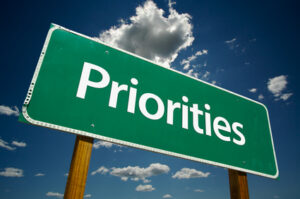
One of the biggest struggles for any adult ADHD is knowing how to priorities your tasks. You have so many tasks on your list and everything feels important. Learning how to prioritize means getting more out of the limited time you have each day and one of the cornerstones of productivity. It can help everything from time management to life balance. To make things easier, I have put together the three of the best strategies on how to prioritize tasks, find the one that works best for you and your ADHD.
Separate the urgent from the important with the Eisenhower Matrix– You may be saying to yourself “Coach Jenna it is all well and good to say you should learn how to prioritize you tasks that brings you the best results but how do you actually do that”? When you’re unsure, the Eisenhower Matrix is a perfect tool to use. It was developed by former US president Dwight Eisenhower, the matrix is a simple four-quadrant box that answers that helps you separate “urgent” tasks from “important” ones. In basic terms, urgent tasks are things you feel like you need to react to right away, like emails, phone calls, texts, or news. While important tasks are ones that contribute to your long-term goals. When looking at how to prioritize tasks best, ask which one of the quadrants they best fit in. And then deal with them accordingly:
–Urgent and Important: Do these tasks as soon as possible
-Important, but not urgent:Decide when you’ll do these and schedule it
-Urgent, but not important:Delegate these tasks to someone else
-Neither urgent nor important:Drop these from your schedule as soon as possible
List your tasks by its true priority with the Ivy Lee Method- Sometimes with our best efforts, as individuals with ADHD, we end up with a huge list of urgent tasks of the things we need to get done. In which case we find a way to dig deeper to find out their true importance. The best way to help with this was created over 100 years ago by a productivity consultant named Ivy Lee. The so-called Ivy Lee Method is a ridiculously easy way to force prioritization of your daily work.
Here’s how it works:
-At the end of each day, write down the six most important things you need to accomplish the next day. Do not write down more than six tasks.
-Prioritize those six items in order of their true importance.
-When you start your day whether at work or at home concentrate only on the first task. Work until the first task is finished before moving on to the next one.
-Approach the rest of your list in the same fashion. At the end of the day, move any unfinished items to a new list of six tasks for the following day.
-Repeat this process every working day.
Limiting yourself to six tasks (or less) each day creates a constraint hat forces you to prioritize properly and then stay focused by single-tasking your way through your list.ons
Separate tasks with seemingly similar priorities using the ABCDE method While the Ivy Lee method is great for prioritizing daily tasks, there’s still one part that’s unclear: How do you know the “true importance” of a task? The biggest unknown when it comes to how to prioritize is differentiating between tasks that feel like they’re on the same level of importance. Here’s where Brian Tracy’s ABCDE method works wonders. Instead of keeping all tasks on a single level of priority, this method offers two or more levels for each task.
This is how this method works-
-Go through your list and give every task a letter from A to E (A being the highest priority
-For every task that has an A, give it a number which dictates the order you’ll do it in
-Repeat until all tasks have letters and numbers
Again, this is a deceptively simple prioritization strategy. While in most cases it’s almost impossible to differentiate between a B1 task and an A3 one, by breaking each task down and giving each task multiple layers of prioritization, you get clarity on what’s truly important to you and what needs to be done and how long it will take you.
In conclusion, setting priorities is great, but as someone with ADHD please try to be realistic about how many tasks you can actually do each day. The reason being some of your tasks may take longer than expected. Interruptions come up. So, while it’s great to know how to prioritize your tasks , you should also be realistic about how much can actually be done. This way, you’ll end the day feeling good about the progress you made and like you can step away and take a well-deserved break.